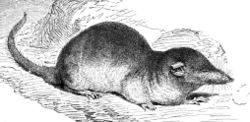| Crocidurinae [1] Temporal range: Miocene to Recent | |
|---|---|
 | |
| Greater white-toothed shrew ( Crocidura russula ) | |
| Scientific classification | |
| Kingdom: | Animalia |
| Phylum: | Chordata |
| Class: | Mammalia |
| Order: | Eulipotyphla |
| Family: | Soricidae |
| Subfamily: | Crocidurinae |
| Type genus | |
| Crocidura Wagler, 1832 | |
| Genera | |
see species list | |
The white-toothed shrews or Crocidurinae are one of three subfamilies of the shrew family Soricidae.
Contents
The outer layer of these shrews' teeth is white, unlike that of the red-toothed shrews which possess iron-reinforced enamel. These species are typically found in Africa and southern Europe and Asia. This subfamily includes the largest shrew, the Asian house shrew, Suncus murinus, at about 15 cm in length, and the smallest, the Etruscan shrew, Suncus etruscus, at about 3.5 cm in length and 2 grams in weight. The latter is possibly the world's smallest extant mammal, although some give this title to the bumblebee bat. Crocidura contains the most species of any mammal genus.
When young must be moved before they are independent, mother and young form a chain or "caravan" where each animal hangs on to the rear of the one in front. This behaviour has also been observed in some Sorex species.